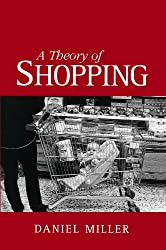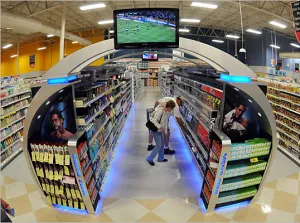When designing POSM there are six key design elements to consider:
1. Color
2. Shape
3. Key visual
4. Text
5. Price
6. Brand logo
More information about how these elements influence the shopper and therefore how you should incorporate them into design can be found in my book; but here is a quick summary.
1. Color
Color helps create contrast from the surroundings and thereby attract visual attention from the shopper
Shoppers use color as one of the means to help them first de-select what is not relevant in their surroundings. To this end, over two-thirds of all fixations in a supermarket are on color.
Tip: use a base color to either connect with the brand’s existing footprint, or choose a high contrast color from the existing category code to draw attention by standing out.
2. Shape
While color can be processed and recognized quickly, the same is not always true for shapes. However, when the shape is unique, or at least in contrast to those around it, there is the possibility of improving the speed with which it is recognized.
Tip: use the combination of shape and color to create an identity that is unique and therefore easier to be recognized quickly by the shopper.
3. Images
Pictures are more memorable than words; they are therefore a key link to building fluency with the shopper in-store. Images are simple to process and are more likely to be viewed before text. When they are used instead of words on in-store signage, they have been shown to increase shopper conversion to purchase.
Tip: prioritize images of people to attract attention over text. Minimize the number of visual elements in the POSM.
4. Text
If it gets their attention, shoppers will look at POSM for just a few seconds, and given their reading speed, are only likely to take in up to five words.
Chances are that they won’t read the whole word either, instead fixating between the beginning and middle of the word when reading it.
Tip: make sure the message uses a large, everyday font, preferably in black, that anchors the meaning of the pictorial.
5. Price
Shoppers engage in very little price comparison in-store. However, shoppers are sensitive to relative prices not absolute prices. Anchoring shoppers in a base price and then showing them the discount, allows them to understand the relative value of the offer.
Tip: show the base price and promoted price together.
6. Brand logo
Mentioning the brand in the headline speeds up the recognition of the POSM. The branding will also receive the most eye fixations per unit of surface area.
Tip: provide branding prominently in the headline.
Works Cited
Birkner, C. (2011). Packaging: Thinking outside the box. Marketing News 30.03
Chen, H. (., Marmorstein, H., Tsiros, M., & Rao, A. R. (2012). When More Is Less: The Impact of Base Value Neglect on ConsumerPreferences for Bonus Packs ove rPrice Discounts. Journal of Marketing July, 64–77.
Cody, S. (2011, JANUARY 15). Consumers, media, advertising, theory and philosophy: The aesthetics of the human face in advertising. Retrieved March 12, 2013, from http://sachacody.blogspot.hu: http://sachacody.blogspot.hu/2011/01/aesthetics-of-human-face-in-advertising.html
Deherder, R., & Blatt, D. (2011). Shopper Intimacy. New Jersey: FT Press.
Dhar, R. (2012, Febraury 16). www.huffingtonpost.com. Retrieved May 5, 2013, from The Irrational Consumer: Four Secrets to Engaging Shoppers: http://www.huffingtonpost.com/ravi-dhar/psychology-shopping_b_1280341.html
Dickson, P. R., & Sawyer, A. G. (1990). The price knowledge and search of supermarket shoppers. Journal of Marketing Vol. 54, No. 3, 42-53.
Franzen, G. (1994). Advertising Effectiveness: Findings from Empirical Research. . Henley on Thames, U.K: N.T.C. Publications.
Garcia, C., Ponsoda, V., & Aranz, H. E. (2000). Scanning Ads: Effects of Involvement and of Position of the Illustration in Printed Advertisements. Advances in Consumer Research Volume 27,, 104-109.
Gibson, S., & Sanger, A. (2001, December). Facilitating the Development of Poster Creativity. World Advertising Research Center.
Hawley, K. J., Johnston, W. A., & Farnham, J. M. (1994). Novel popout with nonsense strings: Effects of predictability of string length and spatial location. Perception & Psychophysics 55 (3), 261-268.
Hill, D. (2010). About face : the secrets of emotionally effective advertising / Dan Hill.
Hoffman, A. L. (2011). Retrieved September 26, 2012, from \”EFFECT OF SIGNAGE AND SUGGESTIVE SELLING ON SALES OF HEALTHY FOOD OPTIONS IN: http://opensiuc.lib.siu.edu/theses/665
Hoffman, J. E. (1998). Attention. Hove, England: Psychology Press/Erlbaum (UK) Taylor & Francis, viii, 407 pp.
Hoyer, W. D. (1984). An Examination of Consumer Decision Making for a Common Repeat Purchase Product. Journal of Consumer Research, Vol. 11, No.3, 822-829.
Itti, L. (2005). Models of bottom-up attention and saliency. Neurobiology of Attention.
Julesz, B., & Bergen, J. (1983). Textons, the fundamental elements preattentive vision and perception of textures. The Bell System Technical Journal Vol. 62 No. 6.
KHAN, U., & DHAR, R. (2010). Price-Framing Effects on the Purchase of Hedonic and Utilitarian Bundles. Journal of Marketing Research Vol. 47, No. 6, 1090-1099.
Lutz, K. A., & Lutz, R. J. (1977). Effects of interactive imagery on learning: application to advertising. Journal of Applied Psychology, Vol 62(4), Aug, 493-498.
Lutz, K. A., & Lutz, R. J. (1978). Imagery-Eliciting Strategies: Review and Implications of Research . Advances in Consumer Research Volume 05 : Association for Consumer Research, 611-620.
MACINNIS, D. J., & PRICE, L. L. (1987). The Role of Imagery in Information Processing: Review and Extensions. JOURNAL OF CONSUMER RESEARCH Vol. 13 March, 473-491.
MacInnis, D., & Price, L. (1987). The role of imagery in information processing: review and extensions. Journal of Consumer Research, 473-491.
Meurs, L. v., & Aristoff, M. (2009). Split-Second Recognition: What Makes Outdoor Advertising Work? Journal of Advertising Research Vol. 49, No. 1, Mar.
Path to Purchase Institute. (2012, June 28). How Can Behavioral Economics Help Develop P-O-P Messaging Strategy? Webinar.
Pieters, R., & Wedel, M. (2007). Goal control of attention to advertising: The yarbus implication. Journal of Consumer Research.
Quinn, T. (2012, January 27). Examining C-store Shoppers From Pump to Register. Conveinence Store News.
Riegelsberger, J., Sasse, M. A., & McCarthy, J. (2004). Trust at First Sight? A Test of Users’ Ability to Identify Trustworthy E-commerce Sites. People and Computers XVII — Designing for Society, 243-259.
Rossiter, J. R. (1982). Visual Imagery: Applications to Advertising. Advances in Consumer Research Volume 09,, 101-106.
Scamell-Katz, S. (2012). The Art of Shopping. London: LID.
Schwartz, M. B. (2007). The influence of a verbal prompt on school lunch fruit consumption: a pilot study. International Journal of Behavioral Nutrition and Physical Activity, 4-6.
Sorensen, H. (2009). Inside the Mind of the Shopper: The Science of Retailing. Pearson Prentice Hall.
Spring, M. B., & Jennings, M. C. (1993). Virtual Reality and Abstract Data: Virtualizing Information. Virtual Reality World, 1.
SymphonyIRI Group. (2012). Merchandising Trends: Driving Consumption through Shopper Marketing.
THALER, R. (1980). Toward a positive theory of consumer choice. Journal of Economic Behavior and Organization l , 39-60.
Treisman, A. (1986). Features and Objects in Visual Processing. Journal Scientific American Volume 255 Issue 5, Nov, 114 – 125.
Tversky, A., & Kahneman, D. (1974). Judgment under Uncertainty: Heuristics and Biases. Science Vol. 185 no. 4157 , 1124-1131 .
Underhill, P. (1999). Why We Buy: The science of shopping. New York: Simon & Schuster.
Vivid brand. (n.d.). Diet Coke. Retrieved June 9, 2013, from www.vividbrand.com: http://www.vividbrand.com/coke-lite/
Vul, E., & MacLeod, D. I. (2006). Contingent aftereffects distinguish conscious and preconscious color processing. Nature Neuroscience, July.
Wedel, M., & Pieters, F. (2000). Eye fixations on advertisements and memory for brands: a model and findings. Marketing science, 297-312.
Wolfe, J. M. (2005). Guidance of visual search by preattentive information. Neurobiology of attention, 101-104.
Yang, S. S. (2012). Eye movements on restaurant menus: A revisitation on gaze motion and consumer scanpaths. International Journal of Hospitality Management Volume 31, Issue 3, September, 1021–1029.
Young, S. (2008, April 1). Designing for the Shopper. Retrieved June 7, 2012, from http://www.prsresearch.com: http://www.prsresearch.com/prs-insights/article/designing-for-the-shopper/





